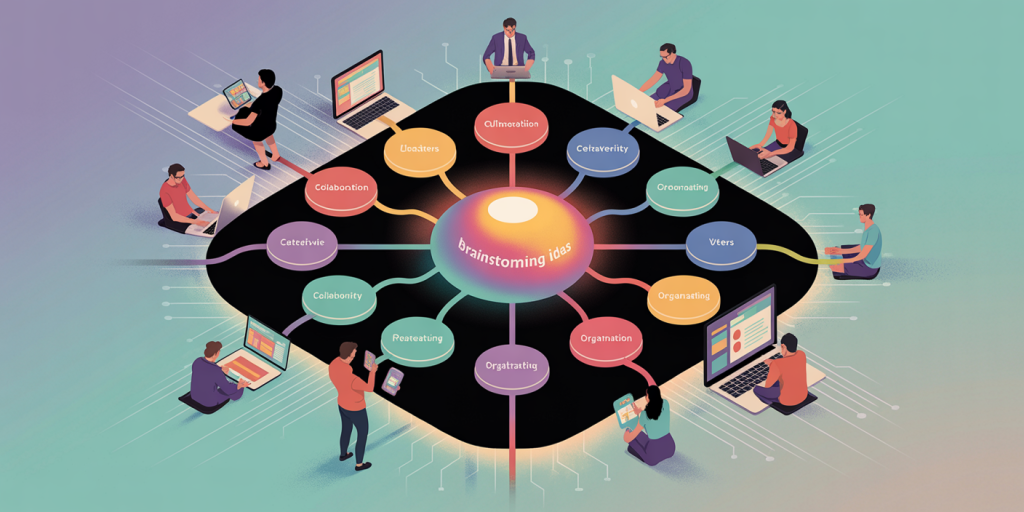Best Free Mind Mapping Tools for Brainstorming Ideas
In today’s fast-paced and idea-driven world, brainstorming effectively is essential for individuals and teams alike. Mind mapping stands as one of the most powerful techniques to visually organize thoughts, generate new ideas, and enhance creativity. Leveraging the right digital tools can significantly improve the brainstorming process by providing structure and flexibility without limiting creative flow.
Fortunately, numerous free mind mapping tools are available that cater to diverse needs—from simple note-taking to complex project planning. These tools help users intuitively connect concepts, collaborate in real-time, and share visual content seamlessly with others. This article explores some of the best free mind mapping software options, supported by practical examples and comparative insights, enabling users to pick the right tool for their brainstorming sessions.
Understanding the Power of Mind Mapping in Brainstorming
Mind mapping organizes thoughts around a central concept and branches out into sub-ideas, giving a clear overview of complex information. Unlike linear note-taking, mind maps foster nonlinear thinking, allowing users to visually break down topics and spot connections that might otherwise go unnoticed.
For example, a marketing team brainstorming campaign ideas may start with a central node labeled “Social Media Campaign,” then branch out into nodes like “Platforms,” “Content Types,” “Target Audience,” and “Budget.” This structure helps the team not only capture ideas quickly but also identify relationships and dependencies. A 2017 study published in the *Journal of Education and Practice* demonstrated that students who used mind mapping techniques improved their memory retention and comprehension by nearly 15% compared to traditional methods.
Additionally, mind mapping supports collaboration, as many modern tools allow multiple users to edit and comment in real-time. This is particularly useful in remote working environments where team members need a shared visual space to brainstorm together, regardless of location. Incorporating mind maps into brainstorming sessions accelerates idea generation and enhances clarity of communication.

Criteria for Selecting Free Mind Mapping Tools
Choosing the best free mind mapping tool depends on several key factors aligned with the user’s needs. First, ease of use is critical; tools with intuitive interfaces enable users to focus on ideas rather than the software itself. Features such as drag-and-drop nodes, keyboard shortcuts, and customizable layouts improve efficiency during fast-paced brainstorming.
Secondly, real-time collaboration capabilities are increasingly important as teams become more distributed. Tools offering seamless multi-user editing, commenting, and version history allow stakeholders to contribute and track idea evolution effortlessly.
Third, export and integration options matter, especially when moving from brainstorming to presentation or project management. Tools supporting popular file formats like PDF, PNG, or integration with platforms like Google Drive or Microsoft Office enhance versatility.
Lastly, limitations such as node count, storage space, or access to premium features within the free tier should be evaluated to ensure long-term usability without forcing immediate upgrades.
To help visualize these criteria, the following comparative table summarizes critical aspects of selected free mind mapping tools:
| Tool Name | User-Friendliness | Collaboration Features | Export Options | Free Tier Limitations | Platform Compatibility |
|---|---|---|---|---|---|
| MindMeister | High | Real-time editing | PDF, PNG, Word | Up to 3 mind maps | Web, iOS, Android |
| XMind | Moderate | Limited collaboration | PDF, PNG, Markdown | Watermark on free export | Windows, Mac, Linux |
| Coggle | High | Real-time collaboration | PDF, Text, Image | 3 private diagrams | Web |
| FreeMind | Moderate | No | HTML, XML, PNG | No cloud storage | Windows, Mac, Linux |
| Canva Mind Map | High | Collaboration via Canva | PNG, PDF, GIF | Limited elements on free plan | Web, iOS, Android |
This table guides users to consider functionality and constraints to pick the optimal free mind mapping tool tailored to their brainstorming requirements.
MindMeister: Seamless Real-Time Brainstorming with Rich Visuals
MindMeister stands out as one of the most popular free mind mapping tools designed explicitly for creative brainstorming and collaboration. Its intuitive drag-and-drop interface allows users to create and edit mind maps effortlessly, while vibrant themes and icons help enhance visual appeal.
A practical example includes a product development team using MindMeister to outline features, identify challenges, and assign tasks during the early stages of project planning. Team members located across different offices can simultaneously add ideas to a shared map, instantly reflecting updates. This dynamic collaboration helped one startup reduce its ideation phase by 30%, according to internal reports.
MindMeister supports exporting mind maps into formats such as PDF and Word, enabling easy inclusion in reports or presentations. However, the free plan limits users to three mind maps, which is a factor to consider for continuous use. Despite this, its comprehensive features in the free tier are well-suited for small teams or individual users focused on brainstorming.
Its wide platform compatibility including web, iOS, and Android ensures users can brainstorm anytime, anywhere, contributing to enhanced productivity and flexibility.
XMind: Robust, Feature-Rich Tool with a Focus on Detail
XMind is a desktop-based mind mapping software favored for its rich set of features and extensive templates. While it offers both free and paid plans, the free version remains a solid choice for users who prioritize detailed maps and structured design.

For instance, educators frequently utilize XMind to create teaching materials and lesson plans, thanks to its ability to incorporate hyperlinks, attachments, and multiple map layouts. One university professor noted that using XMind helped simplify complex course outlines, assisting students in better understanding subject flow.
Although collaboration features are somewhat limited compared to cloud-based competitors, users can export maps in various formats including PDF, PNG, and Markdown, with the caveat that free exports carry a watermark.
XMind’s cross-platform support for Windows, Mac, and Linux gives it an edge for users working across different operating systems, making it a versatile option for professionals requiring detailed and visually appealing mind maps in offline settings.
Coggle: Collaborative Simplicity with Unlimited Visual Expansion
Coggle is a web-based mind mapping tool characterized by its simplicity and strong collaborative functions. It allows unlimited public diagrams and up to three private diagrams in its free plan, making it popular for educational uses and team brainstorming alike.
Teams can use Coggle to visually break down complex projects by inviting multiple collaborators who can add nodes, attach images, and comment directly on branches. For example, a non-profit organization used Coggle to organize volunteer schedules, event planning, and funding ideas in a single map, improving coordination and reducing email threads by 40%.
Its user interface is minimalistic yet powerful, enabling users to add multiple central nodes, making it easier to brainstorm interconnected ideas. Export options include PDF, image files, and text, with an emphasis on easy sharing.
While Coggle’s free plan has limits on private diagrams, its real-time collaboration and straightforward design make it a favorite among educators and small teams managing brainstorming sessions online.
FreeMind: Open Source and Customizable for Tech-Savvy Users
For users who prefer open-source software, FreeMind offers a no-cost, highly customizable mind mapping experience targeting tech-savvy individuals. While it lacks modern aesthetics and cloud collaboration, its extensibility and simplicity appeal to users wanting full control over their brainstorming maps.
For software developers or project managers comfortable with desktop tools, FreeMind supports keyboard shortcuts, node folding, and complex node linking, streamlining the ideation process. A freelance consultant reported using FreeMind to map client workflows, which improved task management and client communication efficiency.
However, as FreeMind does not provide cloud storage or real-time collaborative features, syncing maps across devices requires manual methods like cloud folders (Google Drive, Dropbox).
Despite its older interface, FreeMind’s zero cost and heavy customization make it a good choice for users valuing offline functionality and control over UI elements.
Canva Mind Map: Creative Brainstorming with Design Versatility
Canva, primarily known as a graphic design tool, also offers free mind mapping templates, blending ideation with powerful visual customization. Users can quickly start with a template and enrich their mind maps using Canva’s extensive library of icons, fonts, and images.
This is useful for marketing teams that want to create visually impactful brainstorming boards which easily transform into presentation slides, social media headers, or infographics. For example, a startup used Canva Mind Maps to brainstorm branding strategies, then adapted the map visuals seamlessly into pitch decks.
Collaboration is integrated via Canva’s platform, allowing team members to comment and edit simultaneously. The free plan offers a solid range of elements but limits premium stocks which can be bypassed by uploading custom graphics.
Canva Mind Map’s accessibility on web and mobile, combined with superior design capabilities, makes it ideal for users focused on creative presentations alongside brainstorming.
Future Perspectives of Mind Mapping Tools in Brainstorming
As remote work and hybrid teams become the norm, mind mapping tools are evolving to support increasingly sophisticated forms of collaboration. Future developments are likely to include enhanced AI-powered features that automatically generate connections or suggest ideas based on user input patterns, speeding up brainstorming.
Emerging integrations with virtual and augmented reality may transform mind mapping into immersive experiences. Imagine teams interacting with floating 3D mind maps during brainstorming workshops, providing deeper insight into complex relationships between concepts. This technology could break geographical and disciplinary barriers even further.

Additionally, improved integration with project management and knowledge management systems will allow ideas generated in mind maps to transition directly into actionable tasks and documentation without data loss. AI-driven summarization and sentiment analysis may also enhance group decision-making by highlighting consensus or divergent views in real-time.
Ultimately, free mind mapping tools will continue to democratize creativity and innovation, making visual brainstorming accessible and effective for everyone—from solo entrepreneurs to global organizations.
This comprehensive overview provides a clear path for individuals and teams seeking the best free mind mapping tools suited to their brainstorming needs. By considering usability, collaboration, export options, and platform compatibility, users can select tools like MindMeister, XMind, Coggle, FreeMind, or Canva to streamline ideation effectively. With ongoing advancements in technology, mind mapping’s role in creative thinking is set to become even more powerful and integrated in the future of work.
